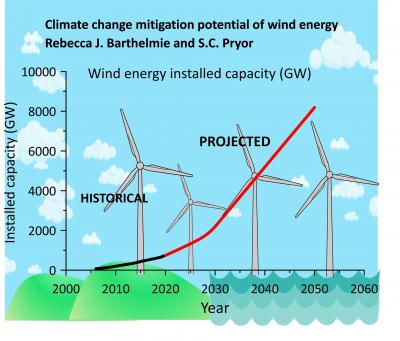Climate Change Mitigation Potential of Wind Energy
We document the historical growth of the wind energy industry, articulate projections for increased installed capacity from different agencies and address the questions; if the projections for this individual renewable energy technology—wind energy—were to be realized what climate change mitigation could be achieved? How will/could different countries and regions contribute to that mitigation? Are there clear barriers to realizing the required expansion of wind energy installed capacity?
As of 2021, wind turbines are now deployed in 90 countries and generate approx. 6–7% of global electricity. Between 2012 and 2021 wind energy installed capacity grew from 282 GW to 742 GW (i.e. at an annualized rate of ~14%). 44 counties, including the USA, plus the European Union have pledged to meet net-zero emissions by 2050. In the USA the goal is net-zero from the energy sector by 2035. Here we examine how continued expansion of wind energy installed capacity can contribute to achieving these goals and indeed how large-scale deployment of this technology can ‘bend the curve’ of global temperatures. All projections of installed capacity considered are possible using existing technologies, and still harness only part of the global wind resource.
The 2021 IPCC report indicates cumulative CO2 emissions are already at 2390 ± 240 GtCO2, and the energy sector continues to represent a significant fraction of annual global greenhouse gas emissions. Further, there remains no expectation of a reduction in energy demand prior to 2050. However, there is a clear need to avoid or at least delay passing the warming threshold of ΔT = 1.5–2°C. We show that if rapid (but technologically feasible) expansion of wind energy installed capacity is undertaken it can still measurably change the trajectory of global temperatures. If wind energy electricity generation capacity were to increase at approx. double current rates and other measures consistent with the IPCC RCP4.5 scenario are implemented, then the ΔT = 2 °C threshold could still be avoided. If rapid expansion of wind energy installed capacity is implemented in the other RCP scenarios (6.0 or 8.5) then it can still significantly reduce global temperature increase at 2100 by 0.3-0.8℃.
While the scale of anthropogenic climate change is daunting, our research illustrates that wind energy can substantially reduce emissions of greenhouse gases at the national and global scale and measurably reduce the amount of temperature increase. The investment needed to achieve this expansion of the wind energy installed capacity is substantial but the levelized cost of energy from wind is competitive, and a sizeable fraction of installed capacity increases may be achieved via repowering or in offshore areas and thus require no additional land.

